KYIV, Ukraine — Bathed in red light and surrounded by the booming sound of explosions, Ukrainian soldiers and civilians raced against the clock to stanch wounds before their comrades bleed out.
White strobe lights flashed in the darkness, and a woman screamed as they strapped tourniquets on limbs, checked for labored breathing and ran through smoke to evacuate casualties to safety.
The simulated scene repeats on a regular basis in the basement of a run-down military training school near the outskirts of Ukraine’s capital city, where instructors with the Ukrainian outfit KoLeSo and the American nonprofit Task Force Yankee Ukraine teach soldiers and civilians the basics of combat medical care.
“It’s one thing to know how to put a tourniquet on and how to stuff a wound but to save a life in chaos is a whole different thing, and that’s what you’ve got to learn,” said Mike Postupak, 56, who served as a U.S. Marine corporal and now leads Kyiv operations for the American group.
Founded by four U.S. veterans in the early days of Russia’s invasion of Ukraine in February, Task Force Yankee Ukraine has crisscrossed the country to prepare more than 12,000 Ukrainians to treat the unique injuries of war.
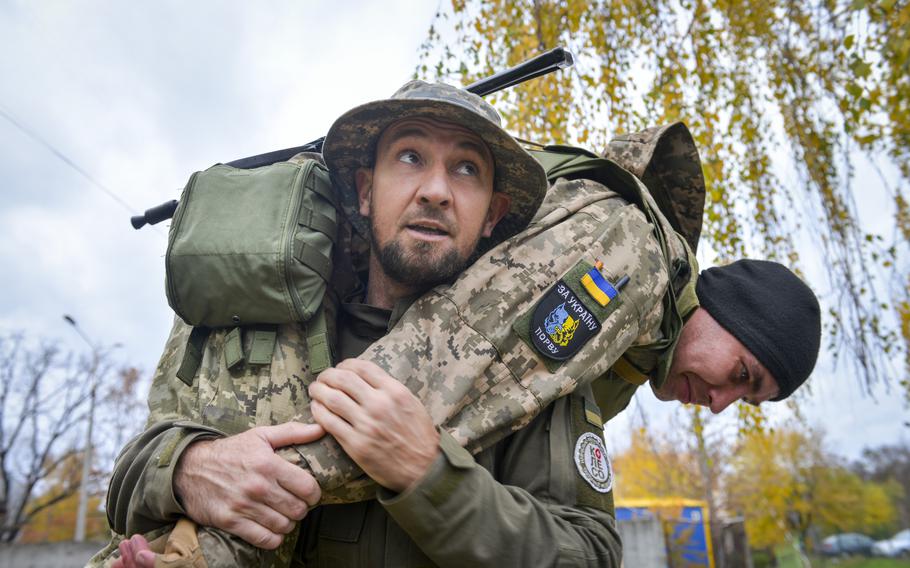
Oleksii Bozhko hefts a Ukrainian soldier as he demonstrates the firefighter’s carry, a method of lifting an injured casualty out of a dangerous area, during training outside Kyiv, Ukraine, on Oct. 27, 2022. Before the Russian invasion, Bozhko enjoyed spending his days kitesurfing on lakes and rivers. (J.P. Lawrence/Stars and Stripes)
They offer an unmatched American military export: training in Tactical Combat Casualty Care, or TCCC, which is considered the gold standard for trauma life support on the battlefield. The set of guidelines developed by the Pentagon aims to identify and stop massive bleeding, respiratory impairment and other ailments caused by serious injury until a casualty can be transported to a hospital.
KoLeSo adapted the methodology for its own training system in 2014, after Russia’s first incursion into Ukraine, and regularly works with Americans to supplement its teaching staff. Members of the all-volunteer Task Force Yankee Ukraine step in several times a week to teach classes and hold their own trainings to meet high demand. The makeup of the group changes frequently. Most are veterans, others are either paramedics or first responders. Some are not Americans.
“We keep this going every day,” American veteran Angel Luna said as he watched a class practice wrapping casualties in foil to retain heat and lessen blood loss. “Most of the people we get have never held a weapon in their hand so this is doing a great deal; and the people we train, they use their knowledge and they train other soldiers. It's a ripple effect.”
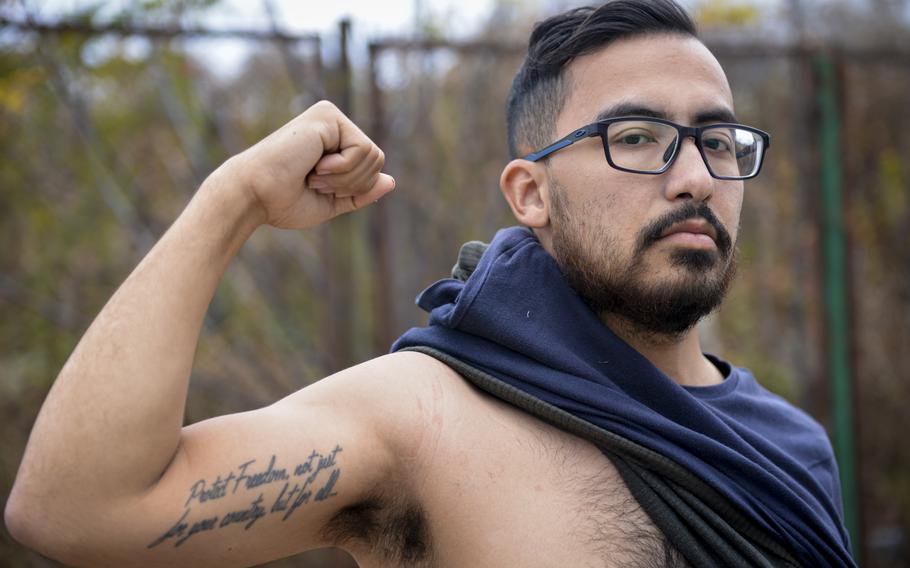
Angel Luna, an American veteran who traveled to Ukraine after the Russian invasion in 2022, shows off his tattoo. It reads “Protect freedom, not just for your country but for all” while at a training site outside of Kyiv on Oct. 27, 2022. (J.P. Lawrence/Stars and Stripes)
Luna, who was a specialist with the North Carolina National Guard, quit his job in a Walmart warehouse in Nebraska to join Task Force Yankee Ukraine in May.
He said he was inspired by the words tattooed on his upper arm: “Protect freedom, not just for your country, but for all.” He had been following Ukraine’s plight since 2016 and flew the country’s blue-and-yellow flag in his yard alongside America’s.
“I truly believe in these people’s freedoms,” said Luna, 30. “I feel I have a purpose.”
That zeal prompted him to drive to Washington, D.C., at the end of February to stand at attention in front of the Ukrainian Embassy where he was arrested for having firearms in his car.
Luna pleaded guilty to a misdemeanor, and he said he served 40 hours of community service.
“What I wanted to do was show the world that America was at the ready to help,” he said.
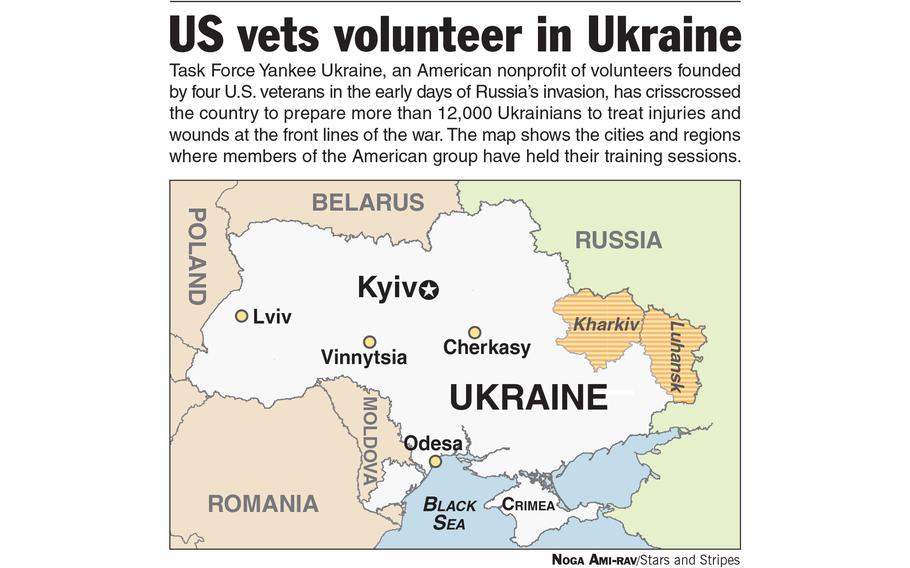
()
Recent missile and drone strikes in Kyiv, where the organization’s operations are based and where there is a hostel where all volunteers stay, have not deterred Luna from his mission. The group’s members also travel widely throughout Ukraine to wherever unit commanders need them, including the Kharkiv, Luhansk, Odesa, Cherkasy, Vinnytsia and Lviv regions.
“I understand the risks, and I accept them,” Luna said. “Any one of us here can die any second, but it doesn’t scare me, I’m going to go out there and help.”
The attacks on the capital in mid-October after months of relative calm rattled the civilian population so much that Task Force Yankee Ukraine is now largely training government employees and other nonmilitary city residents, Postupak said.
“It seems to me that they’re kind of feeling the reality of it,” he said. “I stress the point, especially to a lot of the government workers, that you are probably a target on someone’s map and what happened Monday can happen to you here today and maybe your dear friend who you loved is bleeding out in front of you so please learn this.”
Postupak arrived in Kyiv from Oregon in September after itching to come to Ukraine’s aid for months. He is the son of a Ukrainian immigrant father and has family in the country he helped advise as they fled their homes for a cottage in the woods at the start of the war.
.jpg/alternates/LANDSCAPE_910/041122TRAININGphoto09%201.jpg)
U.S. Marine veteran Mike Postupak watches as Ukrainian soldiers and civilians practice first aid at a training site outside Kyiv on Oct. 27, 2022. Postupak said he quit his private security job and put his life on hold to volunteer in Ukraine. (J.P. Lawrence/Stars and Stripes)
“My heart just goes out to the Ukrainian people,” he said.
As Postupak watched Russia’s invasion unfold, he took stock of the skills that he gained through six years of service with the 11th Marine Regiment in the 1980s and decided to put them to use. He was given leave from his private security job, left his wife and two children in the U.S. and tapped into his savings to work as an instructor for no pay until his authorized 90-day stay in Ukraine expires in December.
“It’s fulfilling to see some of the appreciation on people when they’re done,” Postupak said. “Soldiers, for instance, they think they know what to do, but we’ll run a scenario and let them do it and when you point out all the things they missed they realize, ‘Oh crap everybody would’ve been dead with what I knew at this time.’ When they see the difference, they’re so appreciative of that.”
Oleksandr, a 54-year-old freshly minted soldier from the occupied port city of Berdiansk, watched intently as his comrades acted out a casualty simulation on the broken pavement of a parking lot on a recent evening. He had dutifully recited the steps of trauma care hours earlier, straining to recall their correct order as a Ukrainian KoLeSo instructor prodded him.
Nearly everything was new to him.
“I knew almost nothing that I learned today — how to use a tourniquet, how to stop heavy bleeding, how to administer first aid,” Oleksandr said, declining to provide his last name for security reasons. “I didn’t know any of this until today.”
Prior to the war, he tended to a 20-acre farm with 10 cows and other livestock. He was in Russia when the fighting began and spent months getting home to the southern Zaporizhzhia region as sanctions sealed off borders, ultimately traveling back through Crimea.
Oleksandr returned to a city under stifling Russian occupation.
“You can’t breathe there, you can’t live there,” he said.
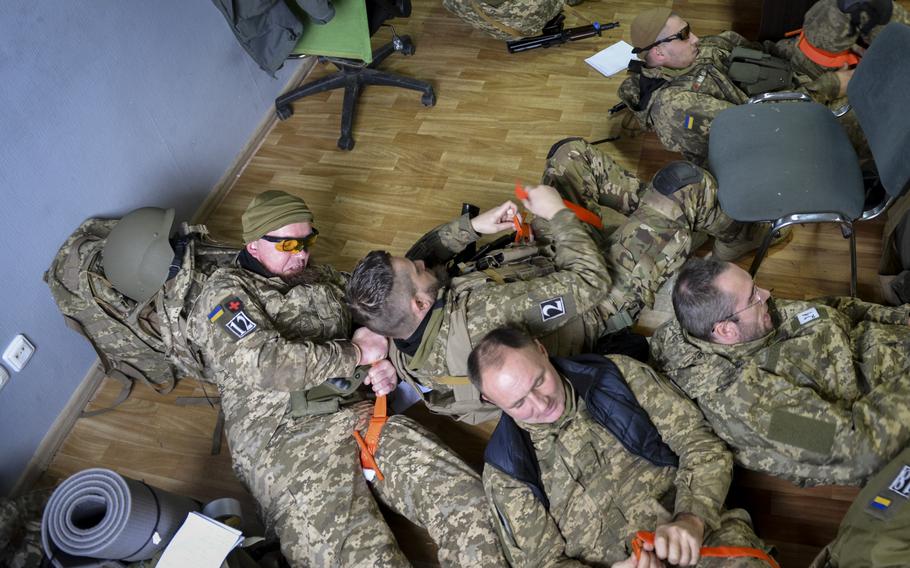
Ukrainian special forces soldiers jump from their seats and dive onto the floor as they rush to put on tourniquets during first aid training at a site outside Kyiv, Ukraine, on Oct. 27, 2022. (J.P. Lawrence/Stars and Stripes)
Oleksandr continued moving toward Ukrainian-held territory, paying people to help him evade certain Russian checkpoints as he crossed through the front line. As soon as he could, he headed to a military recruitment office to volunteer for the army.
“My only wish is to run the occupants from our lands, that’s what we all constantly think about and train for,” Oleksandr said.
In addition to training, Task Force Yankee Ukraine has produced first-aid kits for soldiers deploying to the front, transported about 25 tons of medical supplies and humanitarian aid, evacuated wounded civilians and housed some 300 refugees who flooded into Poland in March, said Joe Meacham, 41, the group’s director of operations and security.
Meacham, a 15-year Army veteran based in Alaska, said the organization is modeled on the structure of an Army or Marine Corps battalion, with staff sections and a command-and-control cell but without “rank or yelling.”
“We have to be delicate because everybody’s a volunteer,” he said.
Most members served in the military, and the group particularly seeks out those with medical training or command experience. Jason Rhind, a 36-year-old from Bermuda, was among the first wave of volunteers with Task Force Yankee Ukraine and had previously served as a teacher and medic in the Royal Bermuda Regiment.
“TCCC is probably one of the most valuable skills you can learn in the military,” he said.
Lidiya Todoraschko, a 42-year-old homemaker, has no intentions of fighting in battle, but she signed up for a first-aid class at the urging of a friend who fought in the country’s eastern Donbas region in 2014 and 2015.
“This is the kind of information that every Kyivan needs to know now,” she said, recovering in the cold air after participating in the red-soaked mass casualty simulation in the basement.
She brought her 18-year-old son, Bohdan, along for the eight-hour day. He is eager to enlist in the Ukrainian army, and she wants him to be prepared in case her efforts to dissuade him fail.
()
“I’m not sure I’ll be able to keep him at home and in case of an emergency, I want to be confident that he can put on a tourniquet and take care of himself,” Todoraschko said.
Postupak said Task Force Yankee Ukraine tailors training to fit its wide range of students. Service members learn how to establish perimeters for evacuations, for example, while civilians might be taught how to check whether areas are safe to enter and, if need be, how to drag a casualty to a safe place, he said.
Masha had little faith that she would be able to do any of the latter. The 28-year-old survived and escaped the siege of Mariupol and, though hardened by the experience, believes she will be just as distraught if faced with a similar situation.
For three weeks, she hunkered down with her family in their fifth-floor apartment as windows were blown out, and the city burned. She avoided sleeping in her bed for two weeks. When she decided finally to spend the night in her bedroom, she woke up to debris narrowly missing her head.
“The state of shock as shards of glass and debris are flying is something I’ve never been in,” Masha said, declining to provide her last name. “You become overwhelmed and lost and don’t know what to do.”
She came to KoLeSo hoping to gain more practice in high-stress situations. Her parents remain in Russian-occupied Mariupol, lucky to be among the few city residents whose home was not significantly damaged or destroyed.
“At least one person in the family should know how to do this,” Masha said.
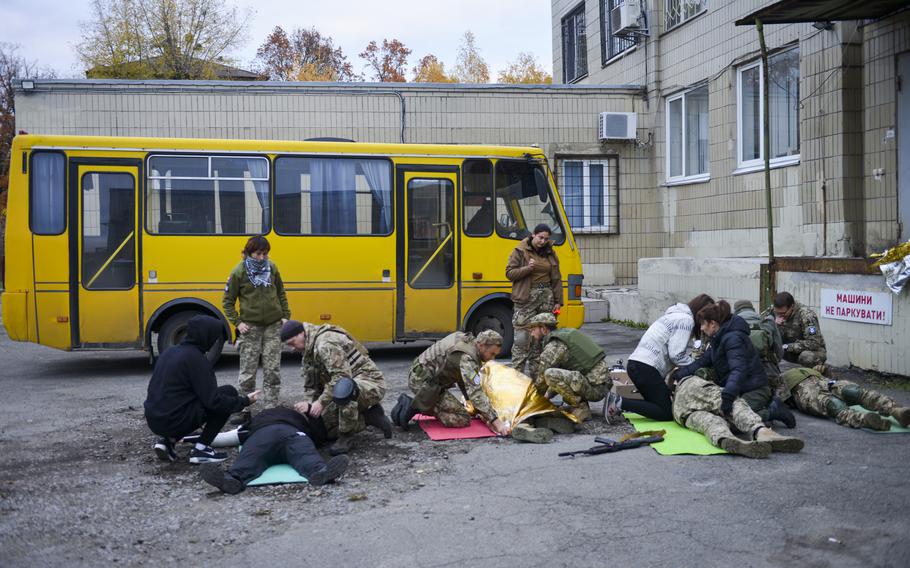
Ukrainian troops and civilians practice first aid Oct. 27, 2022, under the watchful gaze of instructors at a training site on the outskirts of Kyiv, Ukraine. (J.P. Lawrence/Stars and Stripes)
Postupak has big dreams for the future of Task Force Yankee Ukraine as more Ukrainians see the value of preparing for the bloody realities of war even far from the front lines. He wants to add training modules on demining or maybe what to do in the event of a nuclear catastrophe. He would like to expand operations to Zaporizhzhia, but that requires more people.
“We’re a hand-to-mouth organization, the more money we get, the more impact we have,” said Meacham, who was a noncommissioned officer in the service.
The group’s personnel, donations and support have dwindled from peaks in the spring and summer as “Ukraine fatigue” sets in, Postupak said. Volunteers constantly come and go, rotating in and out in 90-day cycles to adhere to the country’s visa laws.
“It’s harder to get people to come over here,” Postupak said. “It’s hard to keep things going.”
Task Force Yankee Ukraine is now working with a skeleton crew of six to eight men and will probably scale down further over the bitter Ukrainian winter, he said. Postupak said he anticipates revving back up again in the spring, though he is not certain whether finances will permit him to come back himself.
Postupak said his mission in Ukraine will not feel complete until he has fine-tuned the training and poured all his knowledge into making it the best it could be. Only then will he be comfortable stepping away.
“This program is good, it’s toward the top notch right now, but you can always do better,” he said. “I’d really like to come back and finish the job. Someone has to do it.”